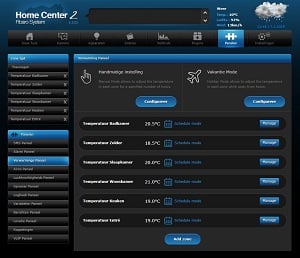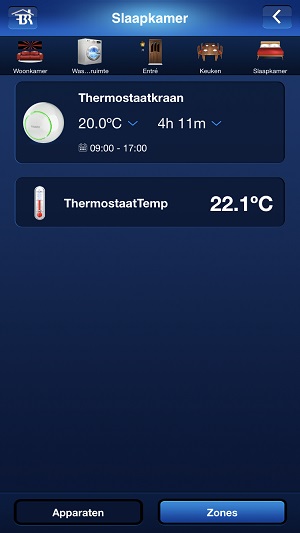
A Smart Home Zone Heating System pays for itself in about 2-3 years, contributes to a better environment, and provides increased comfort with tailored warmth for each room! Read on to see why and how this is a win-win situation!
What is Smart Zone Heating?
The traditional method of hydronic (water) heating involves using a central thermostat in the living room. You set it to your desired temperature, and when the living room reaches that temperature, the boiler turns off. Adjusting the radiator valve in the bedroom or attic does not turn the boiler on and only works when the living room thermostat calls for heat and turns on the boiler. This is not ideal and not efficient.
With zone heating, it is possible to heat multiple rooms independently. Other rooms are not unnecessarily heated, which saves energy. It’s cheaper and more comfortable!

What Do You Need for Zone Heating?
By equipping each radiator and underfloor heating zone with a smart thermostatic valve, you can set the temperature for each room (zone) according to your preferences. Additionally, the boiler needs to be controlled by each of these smart thermostat valves. If one or more thermostatic valves have a set temperature higher than the room temperature, there is a demand for heat, and the boiler will turn on. If none of the thermostatic valves call for heat, the boiler will turn off. The boiler is controlled via a smart thermostat such as the Lisa from Plugwise and the boiler through, for example, the Adam from Plugwise or a smart FIBARO Z-wave Relay Switch. All of this is "coordinated" by the Smart Home System (base station or gateway), such as the FIBARO Home Center 2 or Athom Homey Pro. It can also be combined with electric or hydronic underfloor heating and infrared heating with smart Z-wave or ZigBee modules. The Plugwise system also works standalone via ZigBee and its own app, and does not require a Smart Home Gateway, but it is compatible.
Read on to learn how such a system works with Z-wave and the FIBARO Home Center 2.
Smart Z-wave Wall and Button Thermostats
In principle, you no longer need a wall thermostat for each room (zone) since the thermostatic valves control the temperature per room. These are also available with separate temperature sensors, which you can place in your ideal spot. Often, it is warmer near the radiator than elsewhere in the room. If manually adjusting the thermostatic valve is difficult, because it is, for example, covered or in a convector pit, you can choose a separate smart Z-wave wall thermostat, and let the smart thermostatic valves in the room follow the settings of the wall thermostat (using scenes or associations).

Smart Z-wave Controlled Boiler
Of course, the Smart Home Heating System must also be able to control the boiler. This is directly possible via, for example, the FIBARO Relay Switch, which, like the old-fashioned wall thermostat, turns the boiler on and off. If you prefer OpenTherm/modulating control, you can also integrate a Nest V3 wall thermostat into the Fibaro Home Center 2 and control the thermostat instead of directly controlling the boiler. Additionally, the Nest thermostat will not be used as it is controlled by your Home Center 2.
FIBARO HC2 Heating Schedule
In the FIBARO Home Center 2, you can set a heating schedule for each room (zone) based on time and temperature. These settings are then wirelessly sent via Z-wave to the specific Z-wave thermostatic valves per room (zone), and the rooms are heated according to these settings. You can still manually adjust the temperature via the thermostatic valve itself or through the app, and set how long after a manual adjustment the system should revert to the schedule. For instance, you can automatically turn off the heating 90 minutes before you go to bed, as the room will remain warm for a while.
It is also possible to use geofencing (home or away) to heat only when you or another family member is at home. The FIBARO System detects your smartphone's GPS and knows whether you are at home or away. This way, unnecessary heating is avoided, saving energy. Good for the environment and your wallet.

Manual Control with the FIBARO App
It is also possible to wirelessly adjust the temperature temporarily per room from your comfortable chair or anywhere in the world using the app on your smartphone or tablet. You can also set how long after a manual adjustment the system should revert to the schedule. For your underfloor heating, you will need compact electric 230V radiator valves, as standard Z-wave radiator valves are too large to place close together. You can make these 230V valves smart by controlling them via a Z-wave Switch or Plug. The app will then be the only way to manually open/close (on/off) the valves, as there is no temperature setting on the valve itself. However, if you pair these electric thermostat valves in the Fibaro Home Center with temperature sensors in the rooms, they can be controlled in the app and also in the heating schedule as (virtual) thermostat valves, and set to temperature and time, just like the original Z-wave thermostat valves. This is a significant advantage of the FIBARO Smart Home System.
Energy and Cost Savings with Smart Zone Heating
On average, about 45% of the energy bill goes to conventional gas heating. Therefore, Milieu Centraal had a study done in 2013 to see how much you can save on heating using zone heating and other energy-saving tips.
The research from TU Delft shows that selective heating can lead to significant energy savings. Selective heating means setting different temperatures in various rooms of the house at different times. With a Smart Home Zone Heating System and the following tips, you can save considerably on gas:
- Zone control: do not heat unused spaces or keep it at a maximum of 12 degrees
- Automatic night lowering: 8 hours per night from 20 to 15 degrees
- Automatic lower when absent: 8 hours per day
- Automatic earlier lowering: before going to bed or before leaving for work
- Automatic 1 degree lower: multiple time settings available
When these five functions are consistently used, which is easily achievable with an automatic Smart Home Heating System, you can save an average of about 37% on heating. This translates to an average savings of up to €460 per year. This applies to insulated homes with a radiator or convector heating system and a high-efficiency boiler (70% of homes).
Additionally, underfloor heating pumps that run unnecessarily 24/7, or 8,760 hours/year at about 50 watts, amount to 438 kWh at 22 euro cents/kWh, which is €96 per year. In summer, this is not needed, and in winter, it typically runs only 8 hours per day. You can additionally save about 70% or €67 in electricity if you use a smart plug as a pump switch, which ensures the pump only runs when there is a demand for heat. This also prevents the floor from cooling down quickly, as no cold boiler water is pumped into the floor. Note that it is recommended to run the pump for 2 minutes with open pipes regularly in the summer to prevent the pump and thermostatic valves from seizing up. This can be easily set in your Smart Home System, and you won't have to worry about it further.

A Smart Home System is a Win-Win!
By investing in a Smart Home System, you recoup your investment in about 2-3 years and contribute to a better environment, with increased comfort in each room! You can also use this Smart Home System to automate the rest of your home. It’s a win-win!
Feel free to make an appointment for free advice at home or in the showroom.
FIBARO or Homey is a very complete Smart Home System, with wireless control of all your smart devices, heating, and lighting, all within reach with just one app.
Prefer not to install it yourself? Contact us for our Installation Service.
Contact:
T: +31 85 029 05 78
E: info@home2link.nl

